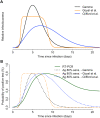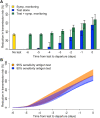Reducing travel-related SARS-CoV-2 transmission with layered mitigation measures: symptom monitoring, quarantine, and testing
- PMID: 33849546
- PMCID: PMC8043777
- DOI: 10.1186/s12916-021-01975-w
Reducing travel-related SARS-CoV-2 transmission with layered mitigation measures: symptom monitoring, quarantine, and testing
Abstract
Background: Balancing the control of SARS-CoV-2 transmission with the resumption of travel is a global priority. Current recommendations include mitigation measures before, during, and after travel. Pre- and post-travel strategies including symptom monitoring, antigen or nucleic acid amplification testing, and quarantine can be combined in multiple ways considering different trade-offs in feasibility, adherence, effectiveness, cost, and adverse consequences.
Methods: We used a mathematical model to analyze the expected effectiveness of symptom monitoring, testing, and quarantine under different estimates of the infectious period, test-positivity relative to time of infection, and test sensitivity to reduce the risk of transmission from infected travelers during and after travel.
Results: If infection occurs 0-7 days prior to travel, immediate isolation following symptom onset prior to or during travel reduces risk of transmission while traveling by 30-35%. Pre-departure testing can further reduce risk, with testing closer to the time of travel being optimal even if test sensitivity is lower than an earlier test. For example, testing on the day of departure can reduce risk while traveling by 44-72%. For transmission risk after travel with infection time up to 7 days prior to arrival at the destination, isolation based on symptom monitoring reduced introduction risk at the destination by 42-56%. A 14-day quarantine after arrival, without symptom monitoring or testing, can reduce post-travel risk by 96-100% on its own. However, a shorter quarantine of 7 days combined with symptom monitoring and a test on day 5-6 after arrival is also effective (97--100%) at reducing introduction risk and is less burdensome, which may improve adherence.
Conclusions: Quarantine is an effective measure to reduce SARS-CoV-2 transmission risk from travelers and can be enhanced by the addition of symptom monitoring and testing. Optimal test timing depends on the effectiveness of quarantine: with low adherence or no quarantine, optimal test timing is close to the time of arrival; with effective quarantine, testing a few days later optimizes sensitivity to detect those infected immediately before or while traveling. These measures can complement recommendations such as social distancing, using masks, and hand hygiene, to further reduce risk during and after travel.
Keywords: COVID-19; Quarantine; SARS-CoV-2; Testing; Travel.
Conflict of interest statement
The authors declare that they have no competing interests.
Figures





References
-
- TSA checkpoint travel numbers for 2020 and 2019 | Transportation Security Administration. https://www.tsa.gov/coronavirus/passenger-throughput. Accessed 5 Nov 2020.
MeSH terms
LinkOut - more resources
Full Text Sources
Other Literature Sources
Medical
Miscellaneous

